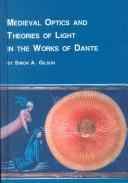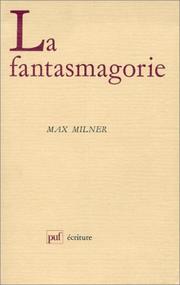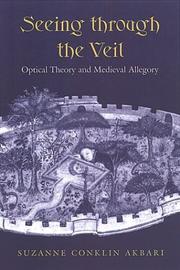| Listing 1 - 10 of 11 | << page >> |
Sort by
|
Book
ISBN: 1421413647 9781421413648 9781421413631 1421413639 Year: 2014 Publisher: Baltimore Johns Hopkins University Press
Abstract | Keywords | Export | Availability | Bookmark
 Loading...
Loading...Choose an application
- Reference Manager
- EndNote
- RefWorks (Direct export to RefWorks)
"Western accounts of human vision before the nineteenth century tended to separate the bodily eye from the rational mind. This model gave way in the mid-nineteenth century to one in which the thinking subject, perceiving body, perceptual object, and material world could not be so easily separated. Christina Walter explores how this new physiology of vision provoked writers to reconceive the relations among image, text, sight, and subjectivity. Walter focuses in particular on the ways in which modernist writers such as H.D., Mina Loy, D.H. Lawrence, and T.S. Eliot adapted modern optics and visual culture to develop an alternative to the self or person as a model of the human subject. Critics have long seen modernists as being concerned with an "impersonal" form of writing that rejects the earlier Romantic notion that literature was a direct expression of its author's personality. Walter argues that scholars have misunderstood aesthetic impersonality as an evacuation of the person when it is instead an interrogation of what exactly goes into a personality. She shows that modernist impersonality embraced the embodied and incoherent notion of the human subject that resulted from contemporary physiological science, and traces the legacy of that impersonality in current affect theory. Optical Impersonality will appeal to scholars and advanced students of modernist literature and visual culture and to those interested in the intersections of art, literature, science, and technology"-- "Christina Walter brings the next offering to the Hopkins Studies in Modernism series. Her work looks at the influence of the modern science of visual perception a variety of modernist writers. Walter focuses in particular on the way in which writers like H.D., Virgina Woolf, Walter Pater, and T.S. Eliot developed an alternative conception of the self in light of the developing neuro-scientific account of our inner workings. Critics have long seen modernist writers as being concerned with an "impersonal" form of writing that rejects the earlier Romantic notion that literature was a direct expression of an author's subjective personality. Walter argues that the charge of impersonality has been overblown and that the modernists did not want to entirely evacuate the self from writing. Rather, she argues, modernist writers embraced the kind of material and embodied notion of the self that resulted from the then-emerging physiological sciences. This work will appeal to scholars and advanced students of modernist literature, as well as scholars interested in the influence of science on literature"--
LITERARY CRITICISM / Semiotics & Theory. --- Optics in literature. --- Modernism (Literature) --- Crepuscolarismo --- Literary movements --- Optics in literature
Book
ISBN: 2130658687 Year: 1982 Publisher: Paris cedex 14 (Humensis 170 bis, boulevard du Montparnasse 75680) : Presses Universitaires de France,
Abstract | Keywords | Export | Availability | Bookmark
 Loading...
Loading...Choose an application
- Reference Manager
- EndNote
- RefWorks (Direct export to RefWorks)
Cette édition numérique a été réalisée à partir d'un support physique, parfois ancien, conservé au sein du dépôt légal de la Bibliothèque nationale de France, conformément à la loi n° 2012-287 du 1er mars 2012 relative à l'exploitation des Livres indisponibles du XXe siècle.
Fantasy fiction --- Optics in literature. --- History and criticism.

ISBN: 0773478086 Year: 2000 Publisher: Lewiston (N.Y.) : Mellen press,
Abstract | Keywords | Export | Availability | Bookmark
 Loading...
Loading...Choose an application
- Reference Manager
- EndNote
- RefWorks (Direct export to RefWorks)
Light and darkness in literature. --- Optics in literature. --- Vision in literature.
Book
ISBN: 9783793095743 3793095746 Year: 2009 Publisher: Freiburg im Breisgau : Rombach,
Abstract | Keywords | Export | Availability | Bookmark
 Loading...
Loading...Choose an application
- Reference Manager
- EndNote
- RefWorks (Direct export to RefWorks)
Electricity in literature. --- Optics in literature. --- Hoffmann, E. T. A., --- Criticism and interpretation.
Book
ISBN: 9781400878222 1400878225 9780691624013 9780691012711 0691624011 Year: 2015 Publisher: Princeton, NJ
Abstract | Keywords | Export | Availability | Bookmark
 Loading...
Loading...Choose an application
- Reference Manager
- EndNote
- RefWorks (Direct export to RefWorks)
In this book the author express more completely than in her earlier studies what were the implications for the poet of a great advance in scientific thought.Originally published in 1966.The Princeton Legacy Library uses the latest print-on-demand technology to again make available previously out-of-print books from the distinguished backlist of Princeton University Press. These editions preserve the original texts of these important books while presenting them in durable paperback and hardcover editions. The goal of the Princeton Legacy Library is to vastly increase access to the rich scholarly heritage found in the thousands of books published by Princeton University Press since its founding in 1905.
Literature and science. --- English poetry --- Poetry and science --- Science and literature --- Science and poetry --- Science and the humanities --- History and criticism. --- Newton, Isaac, --- English poetry. --- Optics in literature.
Book
ISBN: 0814271529 081421097X 0814257534 Year: 2009 Publisher: Columbus : Ohio State University Press,
Abstract | Keywords | Export | Availability | Bookmark
 Loading...
Loading...Choose an application
- Reference Manager
- EndNote
- RefWorks (Direct export to RefWorks)
Objectivity in literature. --- Subjectivity in literature. --- Photography in literature. --- Optics in literature. --- Literature and society --- English poetry --- History --- History and criticism --- Theory, etc.

ISBN: 2130374670 9782130374671 Year: 1982 Volume: vol *96 Publisher: Paris : PUF,
Abstract | Keywords | Export | Availability | Bookmark
 Loading...
Loading...Choose an application
- Reference Manager
- EndNote
- RefWorks (Direct export to RefWorks)
Esoteric sciences --- Fiction --- Optics. Quantum optics --- Comparative literature --- Psychological study of literature --- Thematology --- Optica in de literatuur --- Optics in literature --- Optique dans la littérature --- Fantasy fiction --- Roman fantastique --- History and criticism --- Histoire et critique --- -Fantastic fiction --- Heroic fantasy (Fiction) --- Fantasy literature --- Optics in literature. --- History and criticism. --- -History and criticism --- Optique dans la littérature --- 82 --- CDL --- Fantasy fiction - History and criticism

ISBN: 144261482X 1442655267 1282022520 9786612022524 1442679700 9781442679702 9781282022522 0802036058 9780802036056 9781442614826 9781442655263 6612022523 1442667176 1442659858 Year: 2004 Publisher: Toronto
Abstract | Keywords | Export | Availability | Bookmark
 Loading...
Loading...Choose an application
- Reference Manager
- EndNote
- RefWorks (Direct export to RefWorks)
"In Seeing through the Veil, Suzanne Conklin Akbari examines several late medieval allegories in the context of contemporary paradigm shifts in scientific and philosophical theories of vision." "Offering a new interdisciplinary, synthetic approach to late medieval intellectual history and to major works within the medieval literary canon, Seeing through the Veil will be an essential resource to the study of medieval literature and culture, as well as philosophy, history of art, and history of science."--Jacket.
Literature, Medieval --- Allegory. --- Optics in literature. --- Personification in literature --- Symbolism in literature --- History and criticism. --- Littérature médiévale --- Allégorie --- Optique dans la littérature --- Histoire et critique --- Thematology --- Old English literature --- Old French literature --- Italian literature --- Allegory --- Optics in literature --- History and criticism --- Sex discrimination against women --- Women college teachers --- DISCOUNT-C. --- Women as college teachers --- College teachers --- Women in higher education --- Women teachers --- Literature, Medieval - History and criticism --- Allegorie --- Italienisch. --- Mittelenglisch. --- Mittelfranzösisch.
Book
ISBN: 9782812435485 9782812435492 2812435488 Year: 2016 Volume: 4 35 Publisher: Paris : Classiques Garnier,
Abstract | Keywords | Export | Availability | Bookmark
 Loading...
Loading...Choose an application
- Reference Manager
- EndNote
- RefWorks (Direct export to RefWorks)
Les prédicateurs et les poètes du XVIIe siècle portent un intérêt marqué aux discours savants sur la vision et aux jeux d'optique. Ils y voient en réalité la clé des mystères chrétiens. Avant 1630, ils louent Dieu par le biais de similitudes rhétoriques avec le soleil, puis l'évolution du goût et de la science substitue au thème de la lumière un cabinet d'optique curieuse : miroirs magiques et anamorphoses représentent alors la difficile connaissance du Dieu caché. Après 1630, le socratisme chrétien cherche à le voir au miroir de l'homme. Finalement, l'augustinisme, la crise de l'analogie, et la sensibilité galante fragilisent cette rhétorique de l'optique, au profit de métaphores évoquant les clairs-obscurs de la foi.
French literature --- Literary rhetorics --- anno 1600-1699 --- Optique --- Littérature chrétienne --- Christianisme et sciences --- Dans la littérature --- Thèmes, motifs --- Christian literature --- Optics in literature --- Religion and science --- History and criticism. --- History and criticism --- Thèmes, motifs. --- Dans la littérature. --- Christian literature - History and criticism. --- French literature - 17th century - History and criticism
Book
ISBN: 161811574X 9781618115744 9781618115737 1618115731 Year: 2018 Publisher: Boston, MA
Abstract | Keywords | Export | Availability | Bookmark
 Loading...
Loading...Choose an application
- Reference Manager
- EndNote
- RefWorks (Direct export to RefWorks)
The poetry of Gavrila Derzhavin is a monument to that which could be read, heard, and, most important, seen in the two centuries in which he lived. The Palladian villa he occupied, the British service placed on the table before him, the English spinning machine put to use on his estate, and even the optical devices, such as the telescope, magic lantern, and camera obscura, which populated his home: Tatiana Smoliarova restores Derzhavin's visual environment through minute textual clues, inviting the reader to consider how such impressions informed and shaped his thinking and writing, countering the conservative, Russophile ideology he shared in his later years. In examining the poetics, aesthetics, and politics of Derzhavin's poems written in the early nineteenth century, Three Metaphors for Life makes us see this period as a chapter in the contradictory development of Russian modernity-at once regressive and progressive, resistant to social reform, insistent on a distinctly Russian historical destiny, yet enthusiastically embracing technological and industrial innovations and exploring new ways of thinking, seeing, and feeling.
Russian literature --- Metaphor in literature. --- Symbolism in literature. --- Optics in literature. --- Meteorology in literature. --- Signs and symbols in literature --- Symbolism in folk literature --- History and criticism. --- Derzhavin, Gavriil Romanovich, --- Державин, Гавриил Романович, --- Державин, Г. Р. --- Derzhavin, G. R. --- Derjavine, Gavril Romanovitch, --- Deržavin, Gavrila Romanovič, --- Criticism and interpretation. --- History and criticism
| Listing 1 - 10 of 11 | << page >> |
Sort by
|

 Search
Search Feedback
Feedback About UniCat
About UniCat  Help
Help News
News